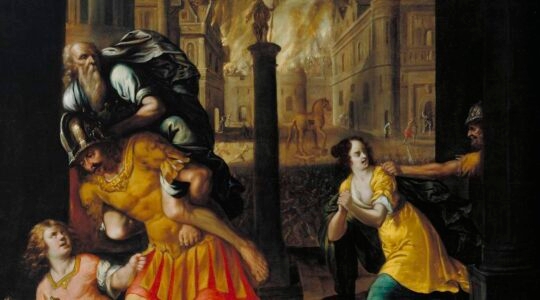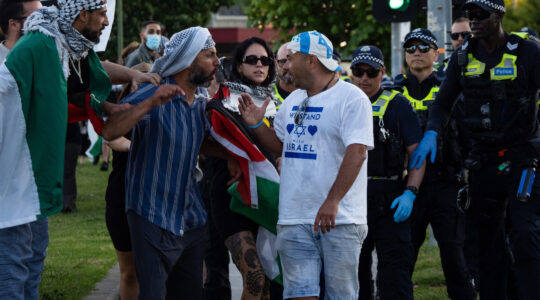PRAGUE (JTA) – As some 200 neo-Nazis marched past the second-largest synagogue in Europe last Saturday afternoon, many of the skinheads and hooded youths looked into the faces of Jews that had gathered on the synagogue’s steps and laughed at them.
The 50 counter-protesters looked helpless and angry, having failed to stop the neo-Nazi march down the main street in Pilsen, 56 miles southwest of Prague.
“I would call this march a complete disaster,” said Tomas Kraus, executive director of the Czech Federation of Jewish Communities. “It never should have been allowed to happen.”
With extremist demonstrations rising across Europe, Jewish groups, lawmakers and municipalities are struggling to find ways of limiting public displays of racism and anti-Semitism in countries where Jews nearly were eliminated by the Holocaust.
The challenge for authorities is how to curtail demonstrations of neo-Nazism without impinging on the right to free assembly.
There have been five public neo-Nazi gatherings since last November just in the Czech Republic – a country with a reputation for religious and ethnic tolerance that is comparatively less xenophobic than many other post-Communist states.
None of the marches have been larger than 200 participants, who usually are loosely identified with international neo-Nazi movements like Blood and Honour or local groups like National Resistance. They are careful not to show any outward signs of racism that would violate Czech law, instead expressing solidarity with those they see as their allies.
In Pilsen, the marchers paid tribute to the Palestinians.
Experts say the problem of neo-Nazi marches is fastest growing in Eastern Europe, where authorities are least experienced at coping with the neo-Nazi gatherings.
In the former Eastern bloc, racist groups often are comprised of frustrated youth reacting against globalization and struggling with the loss of powerful national identities that characterized their parents’ lives, according to Michael Whine, a security expert for the Board of Deputies of British Jews and a consultant for the European Jewish Congress.
For their part, these emerging democracies find it difficult to curtail free-speech rights, even when that speech is hateful, Whine said.
”States that were occupied by Nazis and Russians had 70 years of banning free speech. It is understandable that they are libertarian in their outlook,” he said. “Their courts are very reluctant to ban anything.”
By contrast, he points out, British police recently banned neo-Nazi groups from marching through a London neighborhood with high a concentration of Caribbeans and Asians. “The police said no, it would cause violence, and that was that,” Whine said.
In the United States, neo-Nazi expressions, including the distribution of racist and anti-Semitic materials and public display of the swastika, are protected by the First Amendment right to free speech. In most of Europe, such activity is criminal.
However, U.S. authorities know from decades of experience that the timing and place of provocative marches can be regulated.
Europe is experimenting with different types of regulation.
Recent actions in Germany demonstrate how regulation can limit the level of public neo-Nazi activity.
In 2006, the eastern German state of Brandenburg prohibited marches near cemeteries, as neo-Nazis often gather there to glorify former Nazi officers. After neo-Nazis began shifting their activities to the neighboring state of Saxony, that state passed a law last month to ban neo-Nazi marches on specific dates, such as key Jewish or Nazi anniversaries. The law also banned marches at certain sites, including the old town of Dresden, former concentration camps and synagogues.
Paul Goldenberg, who steers a European program to combat hate crime, said when it comes to evaluating requests for permits, towns always should check if a key anniversary date is involved, such as a Nazi leader’s birthday or death.
“Town officials should also speak to their minority groups and see if they feel their safety is threatened by the marchers,” he said. “They should also reach out to law enforcement agencies to see if a group applying for a permit has any history of violence.”
Goldenberg, who is a former chief of the New Jersey attorney general’s hate-crime unit, is the lead expert for a program run by the Organization for Security and Cooperation in Europe (OSCE) that trains police to combat hate crime.
He said officials and police in Eastern Europe need to get used to checking internet blogs to see if groups planning marches might provoke violence.
“I can rattle off 30 incidents where people have been beaten to death,” Goldenberg said. “Sometimes banning is the only way.”
In the case of last Saturday’s march in Pilsen, organizers called the march to protest an incident last November, when authorities in Prague banned a neo-Nazi march through the city’s storied Jewish Quarter on the anniversary of Kristallnacht. Police nipped that demonstration in the bud when some 400 marchers tried to assemble.
This time, Pilsen’s mayor tried to ban the march, but a regional court struck down the ban because a lower-level city administrator had already permitted the march.
The administrator did not check on the background of the march leader, who according to Czech media is affiliated with several hate groups.
“The marchers should not have been allowed near a synagogue,” Kraus, the Jewish official, said.
Aside from banning marches and limiting when and where they can take place, experts say governments need to improve monitoring of neo-Nazi activity and bolster tolerance education to deter rising neo-Nazi sentiment across Europe.
”There is an increase according to anti-fascist journals and reports by European security services,” Whine said.
No single European agency keeps track of the total number of neo-Nazi events or groups, despite repeated European Union pledges to step up monitoring of anti-Semitic incidents. “That data deficit in itself is a hindrance to local authorities,” Whine said.
Among the high-profile neo-Nazi and ultranationalist demonstrations within the last year were:
* May 1, 2007: marches of up to 5,000 neo-Nazis in several towns in eastern Germany;
* October 2007: the arrest of 30 neo-Nazis in Novi Sad, Serbia, for attacking anti-fascists. Those arrested, including Slovaks and Bulgarians, were defying a ban on a march coinciding with the birthday of Nazi commander Heinrich Himmler;
* December 2007: a march of 900 people in Salem, Sweden, commemorating neo-Nazi activist Daniel Wrestrom.
There also were small events in Holland and Belgium.
Outside the European Union, in Russia and Ukraine, neo-Nazi demonstrations are more frequent and larger than in Western Europe. More law-enforcement training, judicial expertise and societal change is needed in both Russia and Ukraine to make a dent in neo-Nazi movements, anti-racism organizations say.
Within the European Union, Whine and other experts interviewed by JTA said the actual number of neo-Nazis is not necessarily on the rise.
“The numbers are down for Austria and Germany, for instance,” Whine said. “But small groups are more active now. They focus their hostility against immigrants and minorities, but obviously they are also anti-Semitic.”
JTA has documented Jewish history in real-time for over a century. Keep our journalism strong by joining us in supporting independent, award-winning reporting.





